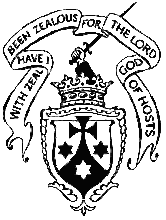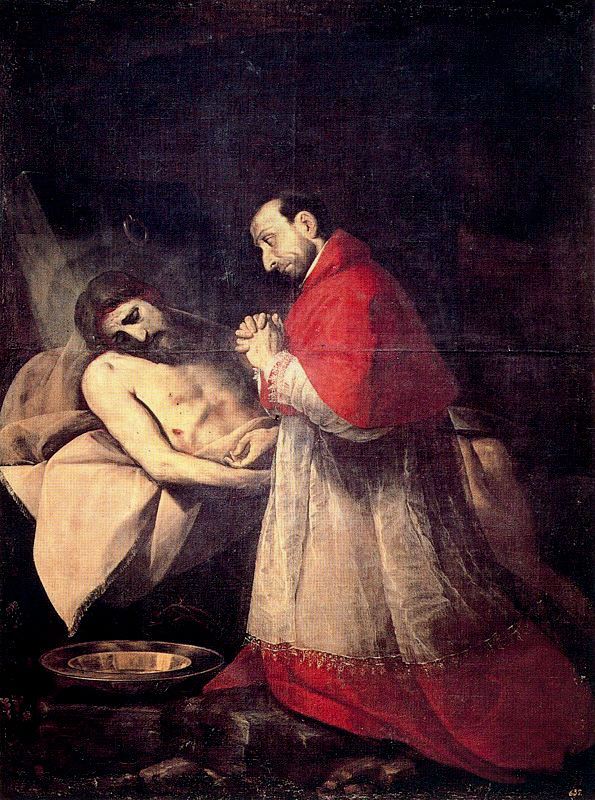Thursday, November 4, 2010
Memorial of St Charles Borromeo
"Charles, of the noble family of Borromeo, was born at Milan. In foretoken of his holy life, God caused a bright light to shine by night over the chamber where his mother lay in travail. As soon as his age would allow him, he received the tonsure. When he was twelve years old, he was made Abbot but reminded his father that the revenues thereof were not be used as mere family property. His father, to whom the administration of these revenues fell during his son's non-age, still gave them forthwith over to him, and whatever was left over, he gave to the poor. While he was young he studied letters at Pavia. He kept his purity thoroughly, so that he scared away the unclean women, of whom many were set upon him, to overthrow his self-control. In the twenty-third year of his age, his uncle, Pius IV, made him a Cardinal, in which dignity he was a burning and shining light of godliness and all graces before the whole of the Sacred College. About forty days afterwards the same Pope created him Archbishop of Milan. As such it was his great desire to order the Church committed to his charge in accordance with the requirements of the most holy Council of Trent, which was in great part by his labours brought to a conclusion. To raise up the degraded lives of the people, he oftentimes held Synods, but himself set an example of deep godliness. He worked earnestly to purge the parts about the Alps and borders of Switzerland of heresy, and brought many of the heretics to the Christian faith.
Charity was the brightest mark of his life. His principality of Oria he sold for forty thousand crowns, and gave the whole sum to the poor in one day. Twenty thousand crowns being left him as a legacy he gave the whole to the poor. The incomes of the benefices wherewith he had been loaded by his uncle, he spent upon the needs of the poor, except what he used for himself. When the plague grievously raged in Milan, he gave up to the sick poor the furniture of his own house, even to his own bedding, and thenceforward slept upon the boards. He constantly visited the sick, cheered them by his fatherly kindness, and wonderfully comforted them, ministering to them with his own hands the Sacraments of the Church. At the same time he drew near to plead for them with God in lowly entreaty, and ordered a public Procession wherein he walked himself carrying a Cross, with a rope halter round his neck, and his bare feet bleeding from the stones, and fain to turn away the Divine anger by offering himself as a scapegoat for the sins of his people. He was a stout defender of the freedom of the Church. But in the Church he was an earnest reformer of discipline, and once, when he was engaged in prayer, some conspirators took a shot at him with a blunderbuss, but, though the ball struck him, the power of God kept him unharmed.
He was remarkable for his abstinence. He very often fasted upon nothing but bread and water, and sometimes nothing but lupines. He tamed his body by depriving himself of sleep, by very rough haircloth, and by constant scourging. He was an earnest practiser of lowliness and meekness. However much he was taken up with business, he never gave himself relaxation from prayer and from preaching the word of God. He built many churches, convents, and schools. He wrote much matter, useful more especially for the good of Bishops. The publication of the Parish Priests' Catechism was due to his care. In October 1584, he withdrew himself, for the purpose of making a retreat, to the Sacro Monte of Varallo, an hill whereon the incidents of the Lord's sufferings are represented in life-size groups of coloured figures. He was taken ill of an ague, and lived there for some days a life of torture by voluntary suffering, but of sweetness by thoughts of Christ's woes. After his return to Milan, his sickness became hopeless, and early in the night between the 3rd and 4th days of November, in the 47th year of his own age, and in that of our Lord 1584, covered with ashes and sackcloth, and with his eyes fixed upon the image of Christ crucified, he exchanged earth for heaven. He was famous for miracles, and Pope Paul V numbered him among the Saints."
-- From the Breviary of St Pius X (1955 ed)
** Painting by Giovanni Battista Crespi il Cerano
Charity was the brightest mark of his life. His principality of Oria he sold for forty thousand crowns, and gave the whole sum to the poor in one day. Twenty thousand crowns being left him as a legacy he gave the whole to the poor. The incomes of the benefices wherewith he had been loaded by his uncle, he spent upon the needs of the poor, except what he used for himself. When the plague grievously raged in Milan, he gave up to the sick poor the furniture of his own house, even to his own bedding, and thenceforward slept upon the boards. He constantly visited the sick, cheered them by his fatherly kindness, and wonderfully comforted them, ministering to them with his own hands the Sacraments of the Church. At the same time he drew near to plead for them with God in lowly entreaty, and ordered a public Procession wherein he walked himself carrying a Cross, with a rope halter round his neck, and his bare feet bleeding from the stones, and fain to turn away the Divine anger by offering himself as a scapegoat for the sins of his people. He was a stout defender of the freedom of the Church. But in the Church he was an earnest reformer of discipline, and once, when he was engaged in prayer, some conspirators took a shot at him with a blunderbuss, but, though the ball struck him, the power of God kept him unharmed.
He was remarkable for his abstinence. He very often fasted upon nothing but bread and water, and sometimes nothing but lupines. He tamed his body by depriving himself of sleep, by very rough haircloth, and by constant scourging. He was an earnest practiser of lowliness and meekness. However much he was taken up with business, he never gave himself relaxation from prayer and from preaching the word of God. He built many churches, convents, and schools. He wrote much matter, useful more especially for the good of Bishops. The publication of the Parish Priests' Catechism was due to his care. In October 1584, he withdrew himself, for the purpose of making a retreat, to the Sacro Monte of Varallo, an hill whereon the incidents of the Lord's sufferings are represented in life-size groups of coloured figures. He was taken ill of an ague, and lived there for some days a life of torture by voluntary suffering, but of sweetness by thoughts of Christ's woes. After his return to Milan, his sickness became hopeless, and early in the night between the 3rd and 4th days of November, in the 47th year of his own age, and in that of our Lord 1584, covered with ashes and sackcloth, and with his eyes fixed upon the image of Christ crucified, he exchanged earth for heaven. He was famous for miracles, and Pope Paul V numbered him among the Saints."
-- From the Breviary of St Pius X (1955 ed)
** Painting by Giovanni Battista Crespi il Cerano
Subscribe to:
Post Comments (Atom)














No comments:
Post a Comment